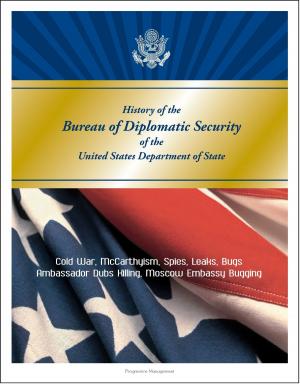Eisenhower: Military Assistance Policies During the Eisenhower Administration - Shaped by World Events, Reorganization Around Findings of Draper Committee, Five Regional Policies
Nonfiction, Social & Cultural Studies, Political Science, Politics, Arms Control, History, Military, United States| Author: | Progressive Management | ISBN: | 9781370855261 |
| Publisher: | Progressive Management | Publication: | March 16, 2017 |
| Imprint: | Smashwords Edition | Language: | English |
| Author: | Progressive Management |
| ISBN: | 9781370855261 |
| Publisher: | Progressive Management |
| Publication: | March 16, 2017 |
| Imprint: | Smashwords Edition |
| Language: | English |
This report has been professionally converted for accurate flowing-text e-book format reproduction. When World War II ended, the U.S. was left as one of the remaining superpowers. Although the Soviets were also very strong militarily, the U.S. found itself as the one nation with the most stable political and economic conditions, as well as being one of the two remaining military superpowers. With the U.S. home soil untouched by war, the economic and manufacturing infrastructures of the U.S. were stronger than ever. This situation set the stage for the start of U.S. assistance programs. In the late 1940s and throughout the Eisenhower Administration, world events shaped the U.S. military aid policies for years to come. The military aid programs during the Eisenhower Administration would see a policy shift from economic aid to mainly military aid and then a reversal of this trend towards the final years of President Eisenhower's second term. The political and economic changes occurring during the 1950s caused the U.S. government to reevaluate, refocus, and reorganize its management of the military assistance programs beginning in the late 1950s. The programs were reorganized around the findings made by the Draper Committee assembled by President Eisenhower. These revamped military aid programs became the cornerstone for military aid programs in the decades to follow and continued to be affected by the constantly changing U.S. foreign policies.
Over the years security assistance programs have been used to help nations who are friendly towards or allied with the U.S. protect themselves. This support is given to promote U.S. national interests and world security. Also these programs have been used to supplement economic aid when the recipient country is believed to have insufficient means to provide for their own defense. The disbursement of military assistance has taken several forms during the course of the program. The U.S. used grants in the early years of the program, with sales of equipment and training becoming more predominant in later years. The first section of the Chapter Two literature review describes the various components of the Military Assistance Program used during the 1950s. Later in 1947, Secretary of State George C. Marshall, outlined as economic assistance program, which became known as the Economic Cooperation Act. The program was in direct conflict with the U.S. historical position on direct economic assistance. Traditionally the U.S. had not been in favor of supplying economic assistance to foreign governments, but the unstable conditions present in Europe presented a clear threat to the U.S.
This report has been professionally converted for accurate flowing-text e-book format reproduction. When World War II ended, the U.S. was left as one of the remaining superpowers. Although the Soviets were also very strong militarily, the U.S. found itself as the one nation with the most stable political and economic conditions, as well as being one of the two remaining military superpowers. With the U.S. home soil untouched by war, the economic and manufacturing infrastructures of the U.S. were stronger than ever. This situation set the stage for the start of U.S. assistance programs. In the late 1940s and throughout the Eisenhower Administration, world events shaped the U.S. military aid policies for years to come. The military aid programs during the Eisenhower Administration would see a policy shift from economic aid to mainly military aid and then a reversal of this trend towards the final years of President Eisenhower's second term. The political and economic changes occurring during the 1950s caused the U.S. government to reevaluate, refocus, and reorganize its management of the military assistance programs beginning in the late 1950s. The programs were reorganized around the findings made by the Draper Committee assembled by President Eisenhower. These revamped military aid programs became the cornerstone for military aid programs in the decades to follow and continued to be affected by the constantly changing U.S. foreign policies.
Over the years security assistance programs have been used to help nations who are friendly towards or allied with the U.S. protect themselves. This support is given to promote U.S. national interests and world security. Also these programs have been used to supplement economic aid when the recipient country is believed to have insufficient means to provide for their own defense. The disbursement of military assistance has taken several forms during the course of the program. The U.S. used grants in the early years of the program, with sales of equipment and training becoming more predominant in later years. The first section of the Chapter Two literature review describes the various components of the Military Assistance Program used during the 1950s. Later in 1947, Secretary of State George C. Marshall, outlined as economic assistance program, which became known as the Economic Cooperation Act. The program was in direct conflict with the U.S. historical position on direct economic assistance. Traditionally the U.S. had not been in favor of supplying economic assistance to foreign governments, but the unstable conditions present in Europe presented a clear threat to the U.S.















